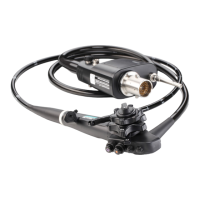62
Directions for use
4
Suction
Warning
Do NOT aspirate solid materials as it may cause a clogging in the suction control valve and /or the
suction channel.
Caution
• Securely attach the cap to the inlet seal. Failure to do so may result in weaker suction strength
as well as potential reflux or dispersal of patient’s body fluids, posing a risk of infection to the
user.
• Do NOT use a cleaning brush or biopsy forceps to remove a foreign object that has occluded
the suction channel. This may result in damage to the channel.
• Observe these precautions when suctioning. Failure to do so may result in mucosal injury to
the patient.
– Do NOT apply excessively high suction pressure.
– Maintain distance between the distal end of the endoscope and the mucosa to ensure
that the instrument channel opening of the distal end of the endoscope does NOT suction
the mucosa.
– Immediately stop suctioning if the mucosa is suctioned. Do NOT suction mucosa for a
prolonged period of time.
– Stop use immediately when any abnormality in controlling suction is suspected.
• When attaching and detaching the suction tube to the suction nipple during inspection, hold
the scope connector with one hand. In addition, do NOT forcefully attach or detach the suction
tube. In case a load is applied to the connection between the video processor receptacle and
the scope connector, failure such as temporary disappearance of endoscopic images may
occur. If any abnormality occurs in the images, connect the scope connector again to the
video processor.
Suction fluid from inside the body cavity through the instrument channel by pressing the suction control
valve.

